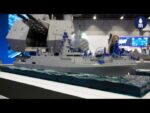The Indian Navy has taken delivery of its first indigenously built Anti-Submarine Warfare Shallow Water Craft (ASW-SWC), named INS Arnala. Designed for littoral anti-submarine operations and built by Cochin Shipyard Limited (CSL), the vessel marks a key milestone in India’s push for naval self-reliance under the “Make in India” initiative.
INS Arnala: A New Class of Coastal Submarine Hunters
INS Arnala is the lead ship of the new ASW-SWC class intended to bolster India’s coastal defense capabilities against underwater threats. Designed by Garden Reach Shipbuilders & Engineers (GRSE) and constructed by CSL under license, the vessel is optimized for shallow water operations — a critical requirement given India’s extensive coastline and growing submarine threat from regional adversaries.
The ship is named after the strategic island of Arnala off Maharashtra’s coast, which historically served as a naval outpost. The vessel was delivered on December 4th, 2023 — coinciding with Indian Navy Day — following successful completion of sea trials in October. Commissioning into active service is expected shortly thereafter.
Specifications and Capabilities
The ASW-SWC class vessels are compact yet potent platforms tailored for anti-submarine warfare in coastal waters:
- Displacement: ~900 tonnes
- Length: ~77 meters
- Speed: >25 knots
- Endurance: ~1800 nautical miles at 14 knots
- Crew Complement: ~57 personnel
- Sensors: Hull-mounted sonar and advanced surveillance systems
- Weapons: Lightweight torpedoes, ASW rockets (likely RBU-6000 or indigenous equivalents), and small-caliber guns for self-defense
- Aviation Facilities: None; not designed to carry helicopters due to size constraints
The vessels are equipped with state-of-the-art combat management systems (CMS) integrated with indigenous sonar suites developed by Bharat Electronics Limited (BEL) and DRDO labs like NPOL. These enable real-time detection and engagement of underwater threats in congested littoral zones where larger frigates may be less effective.
The Strategic Rationale Behind Project ASW-SWC
The Project ASW-SWC program was initiated by the Indian Ministry of Defence to address a critical capability gap in shallow water anti-submarine operations. While India operates major surface combatants like P-15B destroyers and P-17A frigates with robust ASW capabilities, these are optimized for blue-water missions. The need for smaller platforms capable of patrolling estuaries, harbors, and near-shore areas led to this dedicated class.
A total of sixteen ships were ordered under this project — eight each from CSL and GRSE — under a competitive procurement model that promotes public-private participation. The contract was awarded in April 2019 with deliveries scheduled through late 2026. These vessels will eventually replace aging Abhay-class corvettes commissioned in the late 1980s.
Cochin Shipyard’s Role and Industrial Impact
This delivery marks a significant achievement for Cochin Shipyard Limited (CSL), which has traditionally focused on commercial vessels but has increasingly diversified into defense shipbuilding. CSL has invested heavily in modernizing its infrastructure to support naval programs including aircraft carrier construction (e.g., INS Vikrant).
The successful handover of INS Arnala demonstrates CSL’s growing competence in delivering complex warships on schedule. It also reflects broader progress under India’s Defense Acquisition Procedure (DAP) reforms aimed at streamlining procurement and boosting indigenous content across platforms.
Littoral Threat Environment Driving Modernization
The induction of shallow water ASW craft like INS Arnala comes amid increasing regional submarine activity — particularly from China’s PLA Navy operating far beyond its traditional areas into the Indian Ocean Region (IOR). Pakistan too continues to upgrade its submarine fleet with Chinese assistance.
This evolving threat matrix necessitates persistent surveillance along India’s vast coastline (~7,500 km). Larger surface combatants cannot always be deployed efficiently in such roles due to cost or draft limitations. The new SWC class fills this operational void by providing agile platforms capable of high-tempo patrols near choke points like the Malacca Strait or Gulf of Mannar.
Toward Full Operational Capability by Late Decade
The remaining fifteen SWC ships are currently at various stages of construction at GRSE Kolkata and CSL Kochi yards. According to official timelines shared by MoD sources during DEFEXPO events, all units are expected to be delivered by Q4 FY2026–27 barring unforeseen delays.
This phased induction will allow gradual replacement of legacy hulls while enabling doctrinal evolution around distributed littoral warfare tactics using networked sensor grids — potentially linked via BharatNet or future NCW frameworks being explored under iDEX initiatives.









